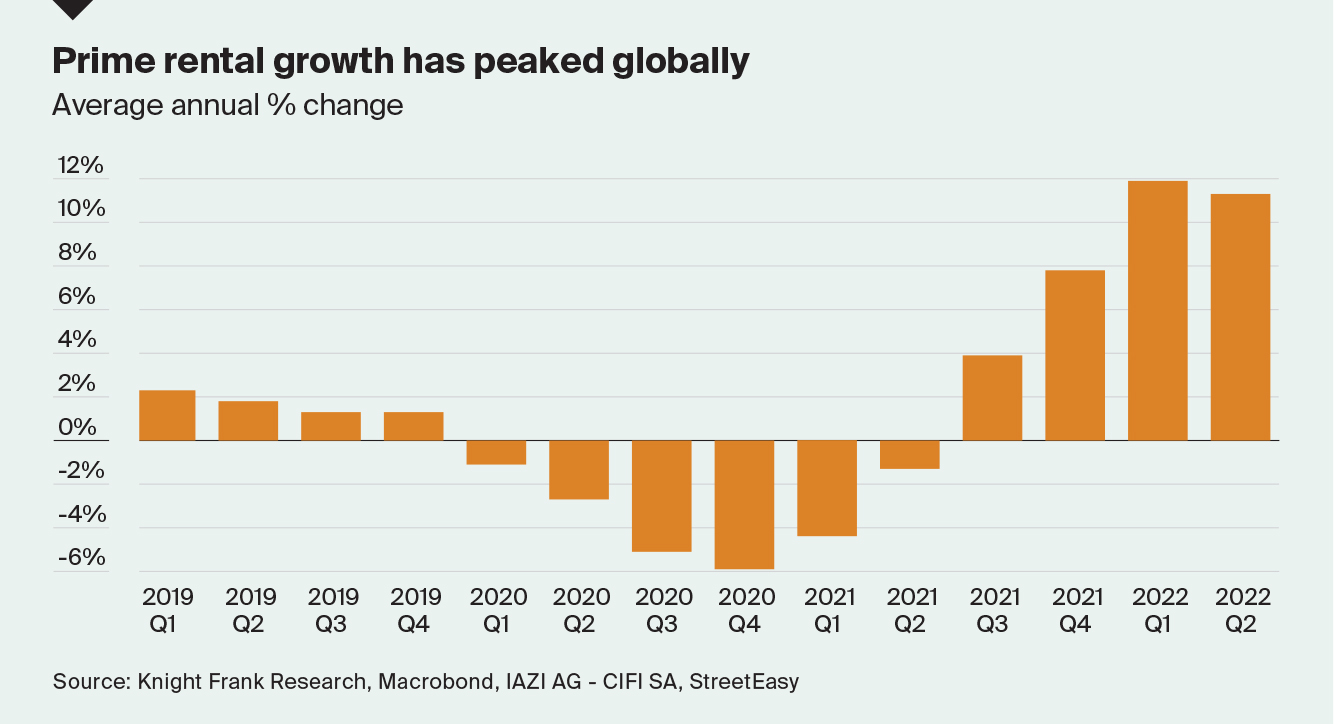New Knight Frank forecasts for house prices and rents
Making sense of the latest trends in property and economics from around the globe
4 minutes to read
New forecasts
A lot has changed since we last issued forecasts for UK house prices and rents back in July.
At the time, the five-year swap rate, which dictates the price of most fixed-rate mortgages in the UK, was below 3%. The Bank of England base rate sat at 1.25%.
The five-year swap rate has in recent days exceeded 5% and the base rate is now at 2.25%. We have revised down our forecasts for the next two years across all UK housing markets to better reflect the more adverse outlook for borrowers.
We expect prices in the UK to fall by 5% next year and again in 2024. That represents a total decline of almost 10% and takes house prices back to the same level as last summer. Prices in the capital will be under additional pressure next year due to higher loan-to-income ratios. For the complete set of numbers, plus more analysis, see this piece on Knight Frank's Intelligence Lab. You can find the Times write up here.
The dust settles
Exactly a week ago I said we wanted the dust to settle slightly before publishing our forecasts. Mortgage lenders were pulling huge chunks of their product lines off the market, the Bank of England was yet to step in with its bond-buying programme and bets on the peak of the base rate had surged beyond 6%.
Conditions remain volatile, but things are certainly less frenetic.
Sterling has rallied for six straight days and, at $1.13, sits above its level the morning of the mini-budget. The Bank of England didn't buy any bonds yesterday, despite laying out plans to spend up to £5 billion a day for two weeks in order to shore up the market. Of the £25 billion it was prepared to have spent by this point, it has purchased just £3.7 billion.
Gilts are stable and both two- and five-year swap rates have fallen back from last week’s peak of 5.9% 5.4% respectively, and are now trading just 50 basis points higher than before the fiscal statement at 4.9% 4.6%. That raises the prospect we'll see cuts to mortgage rates in the coming weeks:
Lenders are "essentially pricing themselves out of taking on lots of work while they assess,” Simon Gammon of Knight Frank Finance tells the FT. “I’m pretty confident that with another couple of weeks of stable swap rates, we could start to see some more sensible rates coming back to the market.”
A peak for luxury rental growth
Growth in prime global rental markets appears to have peaked following months of rapid gains fuelled by a substantial imbalance of supply relative to demand.
Our Prime Global Rental Index increased 11.3% in the year to June, down from 11.9% in March 2022. The dip is small and average annual growth remains in double digits, but growth is now ebbing in some key markets.
New York comes out on top with annual growth of 39%. Prime rents in Manhattan now sit 17% above their pre-pandemic levels. London posted 27% annual growth in the year to June putting it in second place, but recent data shows this figure is starting to ebb. Singapore has leapfrogged Toronto (15.3%) this quarter to take third place with rental growth of 15.8%. April saw the city-state reopen, leading to an uptick in expatriates and returning professionals, with many opting to rent.
The story of the post-pandemic rental recovery will evolve over the coming months, according to Kate Everett-Allen's analysis. Higher mortgage rates have the capacity to increase both demand and supply in the rental sector. Deteriorating affordability in the sales market will push some buyers to rent instead, and with fewer buyers, some sellers may become accidental landlords.

Pausing for breath
Australia's central bank opted for a smaller-than-anticipated 25bps hike yesterday. Reserve Bank of Australia (RBA) Governor Philip Lowe said the rate had "increased substantially" in a short period of time and the Board wanted time to assess the outlook for inflation and growth.
The Board expects to increase rates further, Mr Lowe said, but any easing in the trajectory of tightening would make it a first-mover among global central banks. New Zealand's central bank took the opposite approach overnight, opting for its fifth consecutive 50bps hike.
Last month we touched on the reasons why central banks will find it so difficult to ease off while the Federal Reserve remains on the war path. Research suggests that an interest-rate hike by any major central bank has the effect of exporting inflation to other countries, forcing their fellow central bankers to act when they might otherwise sit tight.
There are still few signs that the Fed will begin easing the pace of tightening. The Fed's preferred measure of inflation continues to run hot, according to data out late last week. The jobs market is cooling, albeit slowly. About 10.1 million positions were open at the end of the summer, down from 11.2 million in July, according to Labor Department data published yesterday. That leaves 1.7 unemployed workers for each available job, close to the highest proportion on record.
In other news...
London's Battersea Power Station reborn as office and shopping hub (Reuters), chief executives shelve ethical and green targets as recession fears mount (Telegraph), and finally, China after the property boom: can it rebuild the growth model? (FT).